Katchoo and Francine are Back in “Strangers in Paradise XXV”
Hanging right beside my desk in my office are framed and autographed copies Strangers in Paradise #90, Francine and Katchoo standing side-by-side on the covers, together at last in the final issue of Terry Moore’s beloved and long-running comic book series about — well, organized crime and birth family and chosen family and childhood abuse and sex work and art and music and friendship and, most of all, two women in love. There’s nothing more formative to my existence than Strangers in Paradise. I remember the day a comic book store owner pressed the first trade paperback into my hands, the exact panel I was looking at when I realized I’m a lesbian, the way I handed the series off to friend after friend as a way to explain my whole queer deal to them, rushing to the mailbox to check for new issues, and holing myself up in my room to scrutinize every fresh page for years and years of my young gay life. So it was no small bit of trepidation I felt last week when I opened up Strangers in Paradise XXV, Terry Moore’s return to my gay bbs on the 25th anniversary of their very first issue.
Rumors about more SiP stories have been around nonstop since the series ended in 2007. Every new comic con, every interview with Moore seemed to tease a resurrection. There were whispers of a novel, a TV show; most recently Angela Robinson was reported to be adapting the series for the big screen. But with the exception of a few sketches and one-off books, Francine and Katchoo stayed locked safely away behind the literal door that closed on the final page of their final book: in a nursery in their home with their babies.
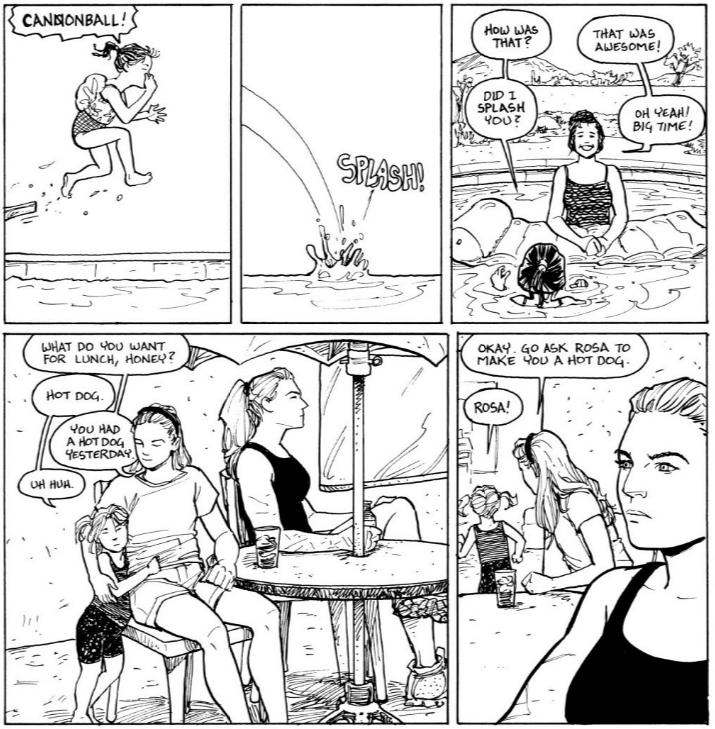
Image via SiP XXV #1, Terry Moore/Abstract Studios
Strangers in Paradise XXV opens with the light streaming out of that same door, thrust wide open after 11 years. However, a decade hasn’t passed inside the book. Katchoo and Francine’s kids are young, maybe four, splashing around in the pool with Mama F and begging hot dogs off of Mama K. Katchoo’s half-sister, Tambi, is there too, just returned from a trip to see her girlfriend(?) Casey. They’re happy and carefree, all smiles and affection and acquiescence to their kids. Things are never that easy, though. Tambi breaks the news that a former Parker Girl (the organized crime syndicate Katchoo was a part of in her youth, and the main thing that kept her and Francine apart throughout the original series) is running her mouth to the Feds, which could mean jail for life — at the very least — for the sisters with the shady pasts. Tambi also briefly rehashes the plot of Echo, Moore’s horror-sci-fi series that followed SiP. Because Strangers in Paradise XXV is going to tie all of Moore’s comic book series together!
Katchoo pulls the ultimate Katchoo in the wake of this news, taking off on a covert mission without telling Francine, running a scam with some Dickensian street kids to steal a guy’s phone to track down his wife (the aforementioned Parker Girl) and then breaking into her house and threatening her husband when she finds Laura Higgs has bolted. It’s secrets and intrigue and lesbian looooove and just so very Terry Moore.
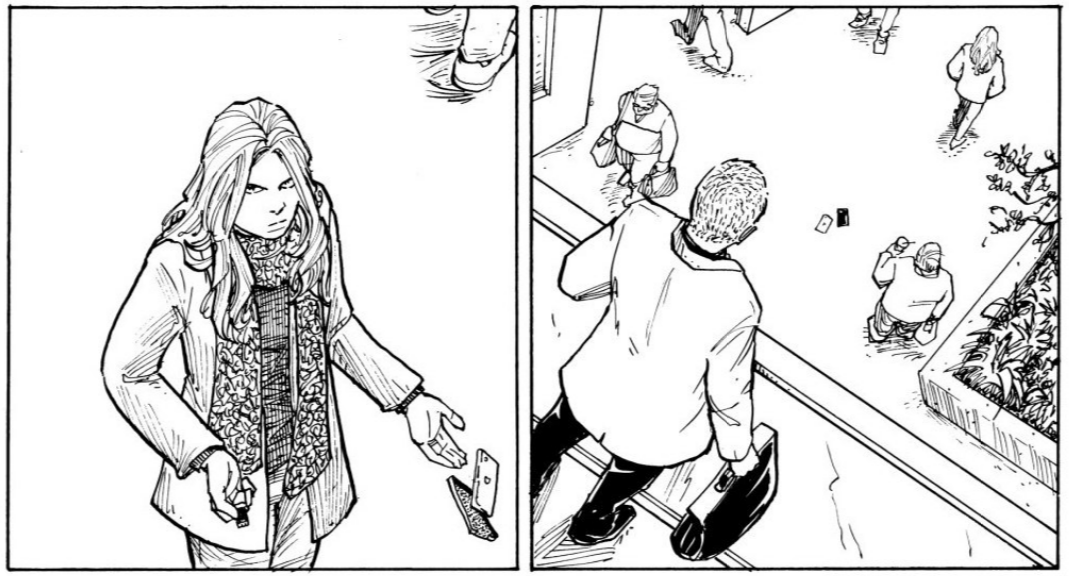
Image via SiP XXV #1, Terry Moore/Abstract Studios
There’s always a danger in engaging with a rebooted series that means so much to you. Will the fictional relationship that helped you piece and hold yourself together fall apart? Will the characters stay true to your memory of them? Will the original ending, that tried and true thing that feels like a tent pole holding up the shape of your heart, hold firm? I actually bought and opened Strangers in Paradise XXV hoping to find a reason not to read it. Maybe I wouldn’t recognize my beloved characters, maybe they’d be unfamiliar to me, maybe I’d changed enough or Terry Moore’s art or storytelling had changed enough that they wouldn’t resonate, land, pierce me. But no. The moment Katchoo appeared, scowling up at the man she was conning, I was all in all over again.
Drawn to Comics: “Strangers In Paradise” Is An Old Reminder Of The Power Of Happily Ever After
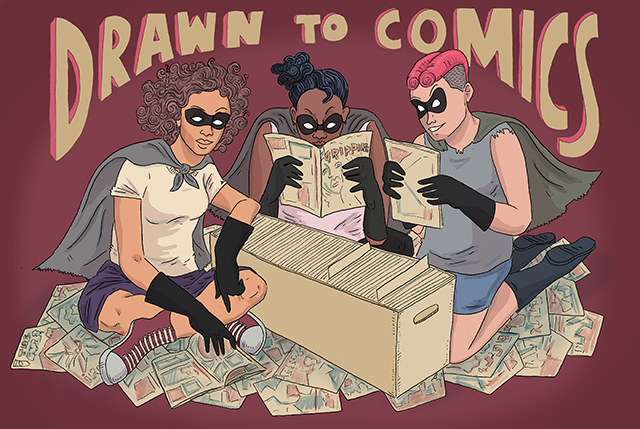
by rory midhani
Last year at New York Comic Con, I walked up to writer/artist Terry Moore‘s booth — press badge around my neck — and burst into tears. 36 years old, working at comic con (like as my actual job), I’d sought out him out to shake his hand and tell him in person how much his long-running series, Strangers in Paradise, had meant to me. I say “in person” because we’d emailed dozens of times before that day at NYCC when I sobbed onto a copy of his 2016 sketchbook and thrust ten dollars into his wife’s hand to cover the cost. I’d interviewed him for various websites. He’d published one of my fan letters in the back of one of his books. All I wanted to do was smile at his face with my face and reiterate my thanks for drawing two women in love. I’d interviewed Wonder Woman herself, Lynda Carter, on the GLAAD Awards red carpet just a few months earlier. How hard could it be to walk by and high five Terry Moore?
Very hard, actually. Impossible. Because it wasn’t the 36-year-old me who waltzed up to his table. I wasn’t a senior editor at the world’s most popular queer lady website, thriving in New York City with my girlfriend of six years. I was younger. Much younger. I was 23 or 24 and all my friends were marrying men and I couldn’t make myself follow their lead, no matter how many times my Baptist pastor urged me to. I didn’t know what was wrong with me, but it was something, and I was scared and I was alone and I hated my job and I hated myself. I had no plans for my future because I couldn’t imagine a future because I’d never seen one (in real life or on TV or in a movie or in a book) that made sense to me.
I was 23 or 24, standing in Galactic Quest comic book shop in Buford, GA, when the owner, Kyle, pressed Strangers in Paradise into my hand. He asked me what kind of books I liked to read and I blurted out “Wuthering Heights” for some reason, and he laughed and told me to take the first SiP trade paperback. He said if I liked it I could come back and pay for it later, and if I didn’t, I could just pass it along to someone else who had a thing for female protagonists who love so deeply the weather changes with their moods. It was a good Brontë joke and when I laughed he flipped the book over and showed me the cast of characters on the back cover: “This is Katchoo,” he said. “She’s in love with her best friend, Francine; this is her. She thinks she’s in love with Freddie, but she’s just scared to admit she’s in love with Katchoo too.”
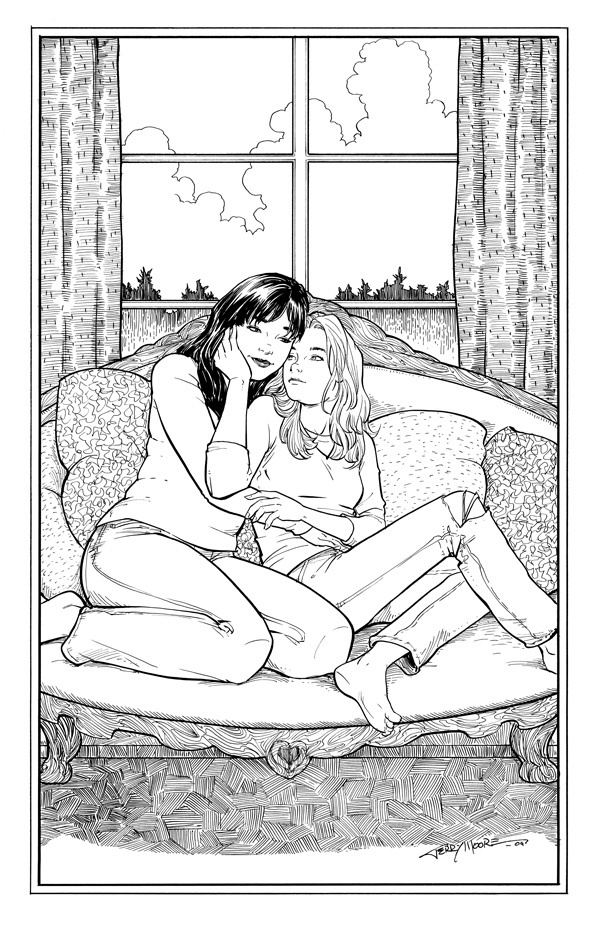
A post-SIP sketch by Terry Moore.
I shoved the book back at Kyle and told him no thank you. My church had been warning me about stuff like this my whole life. You read a book about homosexuals or, say, a boy wizard, and you might get tricked into feeling sympathetic towards them and you might forget how they’re pawns of Satan and you might get dragged right into their lifestyle. Kyle insisted and I relented. It was free and he was so eager to share a comic book he loved.
It turns out my church was right: Ten pages into Strangers in Paradise I realized what Jesus was talking about when he promised that when I found the truth, I’d be set free. Katchoo loved Francine, and it was perfect and heart-wrenching and sweet and sexy and fraught and easy and normal. So normal. Loving another woman — loving another woman — was normal, and I was free.

Francine Peters: The only woman who stayed in the closet longer than I did. She finally said she was gay in Issue #88.
Francine loved Katchoo back; that was obvious before the end of the first trade, but it took 106 issues for them to finally find their way to each other for good and forever. Strangers in Paradise is a lot of things. It’s a love story, for sure. It’s a story about chosen family. It’s a noir mystery and a mob drama and a ’90s sitcom and an art history lesson and a love letter to music and complicated rumination on identity. I used to wait by the mailbox for each new issue to arrive. I’d devour it and then start over at the very beginning and read all the way through again until it was time for the next issue.
I’ve been thinking about Strangers in Paradise these last few days because of something Terry Moore said in the Treasury Edition a long time ago. He started the series in 1993 and had always planned for Francine and Katchoo’s story to have a tragic ending. He thought it’d be bold, and poetic. But September 11 changed the way he thought about story, about his work in the world, and he realized there were enough sad and terrible endings for real people and fictional characters, especially queer ones, and he resolved in the following months to ultimately give his lesbian and bisexual female leads the send-off fans wanted, the send-off they deserved.
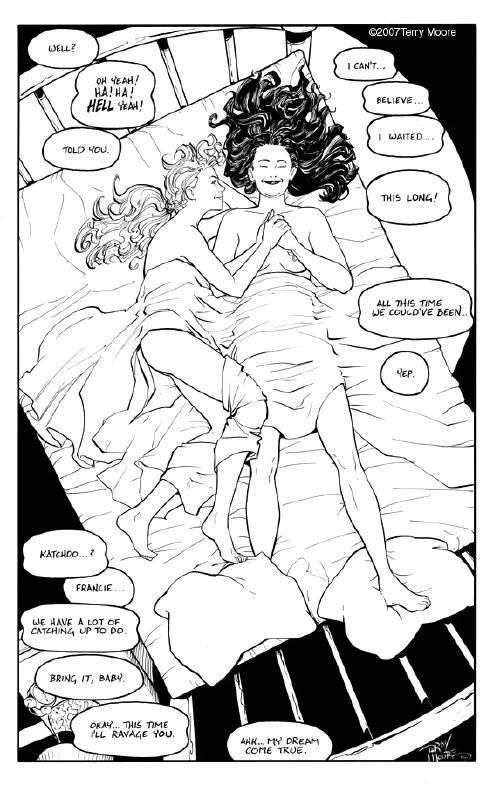
My dream come true, too.
It’s no wonder that I reached for SiP yesterday in the wake of the Orlando attack. It’s a well-worn comfort, a story that tugged me out of the closet and sent me off in pursuit of my dreams, a story that has offered me distraction and reassurance for years.
Over a decade ago, Terry Moore realized what so many storytellers before and after him have been too obtuse to see — that happy endings for gay people aren’t cliche. They’re not the norm. They’re rare and remarkable and we hold them in our hearts forever. I never knew a future until Galactic Quest Kyle wrapped my hands around Strangers in Paradise.
Francine and Katchoo lived happily ever after.
Francine and Katchoo lived happily ever after.
And so can I.
And so can you.